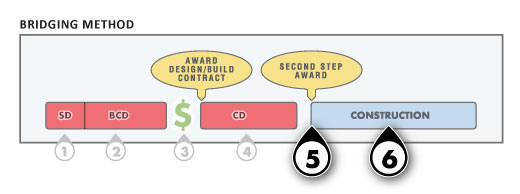CONCLUDING WITH THE 5TH AND 6TH PHASES OF CARRYING OUT A PROJECT BY THE BRIDGING METHOD.
Phase 5. At this point the Owner has the right to terminate the contract without cause by payment of the amount due to the contractor for completion of the CD’s. If the Owner chooses to proceed, the Contractor authorizes construction. Note that (after the proposal has been submitted by the Contractor in Phase 3) the Contractor has no opportunity to adjust the price unless the Owner has approved in writing with a Change Order.
Phase 6. Throughout the construction, the ODC, along with the Owner’s program manager and any other CA specialists the Owner has employed, will observe the work in detail in exactly the same way that the Architect would under the traditional Design-Bid-Build method except the Contractor’s AE (not the ODC) will be responsible for checking all shop drawings, which will be passed on to the ODC with a previously stipulated “grace period”. In turn, the ODC can point out any errors that may be observed, though the ODC is not contractually obligated to carry out a detailed technical review, and may reject and/or require re-submittals. The ODC may then simply let the grace period pass. If the ODC sees fit, the Contractor may be released from a particular grace period requirement (if plausible) in order to be as helpful to the Contractor as possible without endangering the interests of the Owner. A “frozen” set of final BIM output would be provided to the Owner through the ODC along with record up-dated contract documents.
All progress payments will be approved by the ODC or a combination of the ODC and the Owner’s program manager.
As it would be a conflict-of-interests in a typical Design-Build project for the Contractor’s AE to carry out construction administrations (“CA”) services on behalf of the Owner, so would it be a conflict-of-interests for the for the Contractor’s AE to carry out CA services for the Owner in a project being carried out by the Bridging method. The only exception, as stated above, would be the checking of the shop drawings by the Contractor’s AE. However, as also pointed out above, after the Contractor’s AE checks each set of shop drawings there is then a grace period during which the ODC may carry out additional reviews. During the grace period the ODC and Program Manager must have the right to reject the shop drawings and have them re-submitted after corrections are made, again with another grace period. (Additional grace periods are also required for shop drawings that are resubmitted due to errors or misinterpretations by the Contractor’s AE in their preparation. However, these additional grace periods would not be the basis for an adjustment in the time of completion of the construction unless the Owner, ODC or the Program Manager had required that changes be made in the shop drawings resulted from an Owner initiated change after the original shop drawings had been completed.)
Even though the only construction phase service contractually required by the Owner of the Contractor’s AE is the checking of the shop drawings, the Contractor may elect to have its AE provide any number of other services to the Contractor during construction. Typically, those services might be for the Contractor’s AE to act as a part of the Contractor’s staff and consultants in the prosecution of the project. Oftentimes the Contractor will choose to engage its AE to assist in quality control or other activities during construction. That will often improve the overall prosecution of the project. However, that decision will have been a part of the agreement between the Contractor and the Contractor’s AE, presumably undertaken as a result of an internal decision by the Contractor. In any case, however, this cost to the Contractor shall not be a cost that may be passed on to the Owner, ODC or Program Manager except to the extent it may have affected the Contractor’s original contract price.
